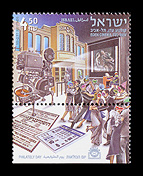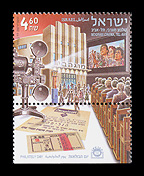|
In the early 1900's, there were, in several towns in Eretz Israel, a few sheds, cafes and other temporary structures in which silent movies were screened, but most of these places lasted for just a few years. The building of modern cinema theaters, in permanent stone structures, started in earnest in the late 1920s, reaching its peak in the mid-1950s. These theaters, be they large ones in centers of entertainment or small neighborhood ones, have become the hub of community life. During the peak year, 1966, 2.6 million Israelis went to the cinema more than 50 million times. Two years later, when television broadcasting began, many Israelis chose to stay at home and watch this new marvel, and cinema theaters closed down – first in the periphery, then in major cities. 330 standalone theaters were torn down, or else redesigned as multiplex theaters. Since the mid-1980s, most cinemas are hidden away inside shopping malls and entertainment centers. The possibility to watch movies using other media such as videotape, DVD and home computer, turned the old movie theater into a distant memory.
Regarded by most as the first modern cinema in Eretz Israel, Eden was built in 1914 amidst conflicts and objections by residents of the Ahuzat Bayit community, Tel-Aviv's precursor. Its owners, Moshe Abarbanel and Mordechai Wieser, demanded and received from the community council a 13-year exclusive francise, making Eden the only location for movie screening in Tel-Aviv. During World War I, Eden Cinema was shut down by order of the Ottoman government, under the pretext that its generator could be used to send messages to enemy submarines off shore. It was reopened to the public once the British mandate was established, soon becoming a cultural and social center. A new open hall was built next to it. Then the monopoly expired, additional cinema theaters were built, and Eden gradually lost its prestige. In the 1950s, following the establishment of the State of Israel, the owners screened Indian and Turkish films to the new immigrants. The Eden cinema was closed down in 1974 and then designated a "preserved building''.
Mogragi Cinema was opened in 1930. Architect Yosef Berlin's design included pressed silicate blocks, reflecting the art deco style then prevalent in cinemas worldwide. ''It was like building the pyramids,'' commented the supervisors on the scale of the building. Massive investments in construction had left it roofless for its first few years, until a sliding roof was built. The 12 steps leading from street level to its doors only reinforced the feeling that one was entering a shrine. The Mograbi Cinema Square became a meeting place well known. Here, people gathered to dance in the streets when the UN General Assembly adopted the Partition Resolution in November 1947. During the 1960s, when high-rise buildings were appearing in Tel-Aviv, entertainment centers moved north. Poor maintenance also contributed to Mograbi's demise. It caught fire in the summer of 1986, due to an electric short-circuit, and was subsequently torn down. City Hall then decreed that Mograbi's original facade will be reconstructed for the new shopping mall due to be built on this site.
David Shalit
Historian of Cinema


